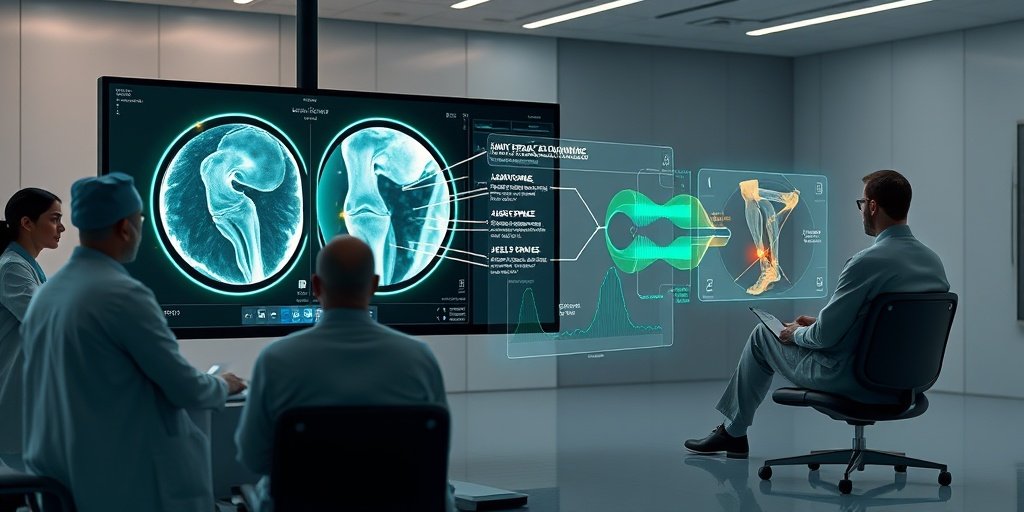⚡ Quick Summary
This study developed the Load-Bearing Tissue Radiomic plus Biochemical biomarker and Clinical variable Model (LBTRBC-M) to predict the progression of knee osteoarthritis (KOA) using longitudinal MRI radiomics and biochemical biomarkers. The model demonstrated a high predictive capability with an AUC of 0.913 for joint space narrowing progression.
🔍 Key Details
- 📊 Dataset: 594 participants with KOA, 1,753 knee MRIs
- 🧩 Features used: MRI radiomics, biochemical biomarkers, clinical variables
- ⚙️ Technology: eXtreme Gradient BOOSTing (XGBOOST)
- 🏆 Performance: AUC for JSN and pain progression: 0.880, JSN progression: 0.913, pain progression: 0.886
🔑 Key Takeaways
- 📊 LBTRBC-M effectively predicts KOA progression using advanced imaging and biomarkers.
- 💡 The model achieved an overall accuracy of 70.1%.
- 👩🔬 The study included a diverse cohort with a mean age of 61.6 years.
- 🏆 The model improved prognostic accuracy of resident physicians from 44.7%-49.0% to 64.4%-66.5%.
- 🌍 Limitations include the use of non-routine MRI sequences and lack of external validation.
- 🔍 JSN progression was defined as a minimum joint space width loss of ≥0.7 mm.
- 📈 Pain progression was assessed using the WOMAC pain subscale.
- 🔮 Future research is needed for external validation and broader application.

📚 Background
Knee osteoarthritis (KOA) is a degenerative joint disease that significantly impacts the quality of life for millions of individuals worldwide. Traditional methods of assessing KOA progression often lack precision and can be subjective. The integration of MRI radiomics and biochemical biomarkers presents a promising avenue for enhancing predictive accuracy and facilitating early intervention strategies.
🗒️ Study
This study utilized data from the Foundation of the National Institutes of Health Osteoarthritis Biomarkers Consortium, focusing on 594 participants with Kellgren-Lawrence grades 1-3. The researchers aimed to develop the LBTRBC-M model, leveraging longitudinal MRI data and biochemical markers to predict KOA progression over a two-year follow-up period.
📈 Results
The LBTRBC-M model exhibited impressive performance metrics, with an AUC of 0.913 for predicting joint space narrowing progression and an overall accuracy of 70.1%. The model’s ability to differentiate between various progression outcomes highlights its potential utility in clinical settings.
🌍 Impact and Implications
The findings from this study could significantly influence the management of KOA by enabling healthcare professionals to identify at-risk patients earlier and tailor interventions accordingly. The use of advanced imaging techniques and machine learning models like LBTRBC-M may pave the way for more personalized treatment approaches, ultimately improving patient outcomes and quality of life.
🔮 Conclusion
This research underscores the potential of combining MRI radiomics and biochemical biomarkers to enhance the prediction of KOA progression. As we move forward, further validation and refinement of the LBTRBC-M model could lead to transformative changes in how KOA is diagnosed and managed, fostering a more proactive approach to patient care.
💬 Your comments
What are your thoughts on the integration of advanced imaging and machine learning in predicting knee osteoarthritis progression? We invite you to share your insights in the comments below or connect with us on social media:
Predicting knee osteoarthritis progression using neural network with longitudinal MRI radiomics, and biochemical biomarkers: A modeling study.
Abstract
BACKGROUND: Knee osteoarthritis (KOA) worsens both structurally and symptomatically, yet no model predicts KOA progression using Magnetic Resonance Image (MRI) radiomics and biomarkers. This study aimed to develop and test the longitudinal Load-Bearing Tissue Radiomic plus Biochemical biomarker and Clinical variable Model (LBTRBC-M) to predict KOA progression.
METHODS AND FINDINGS: Data from the Foundation of the National Institutes of Health Osteoarthritis Biomarkers Consortium were used. We selected 594 participants with Kellgren-Lawrence grades 1-3 and complete biomarker data. The mean age was 61.6 ± 8.9 years, 58.8% were female, and the racial distribution was 79.3% White or White, 18.0% Black or African American, and 2.7% Asian or other non-White. A total of 1,753 knee MRIs were included across the study period, comprising 594 at baseline, 575 at 1-year follow-up, and 584 at 2-year follow-up. Outcomes included (1) both Joint Space Narrowing (JSN) and pain progression (n = 567), (2) only JSN progression (n = 303), (3) only pain progression (n = 295), and (4) non-progression (JSN or pain) (n = 588), corresponding to an approximate ratio of 2:1:1:2. JSN progression was defined as a minimum joint space width (JSW) loss of ≥0.7 mm, and pain progression as a sustained (≥2 time points) increase of ≥9 points on the Western Ontario and McMaster Universities Osteoarthritis Index (WOMAC) pain subscale (0-100 scale). Using the eXtreme Gradient BOOSTing (XGBOOST) algorithm, the model was developed in the total development cohort (n = 877) and tested in the total test cohort (n = 876). In the total test cohort, the Area Under the receiver operating characteristic Curve (AUC) of LBTRBC-M for predicting JSN and pain progression, JSN progression, pain progression, and non-progression were 0.880 (95% confidence interval (CI) [0.853, 0.903]), 0.913 (95% CI [0.881, 0.937]), 0.886 (95% CI [0.856, 0.910]), and 0.909 (95% CI [0.888, 0.926]), respectively. The overall accuracy of LBTRBC-M was 70.1%. With LBTRBC-M assistance, the prognostic accuracy of resident physicians (n = 7) improved from 44.7%-49.0% to 64.4%-66.5%. The main limitations include the use of a non-routine MRI sequence, the lack of external validation in independent cohorts, and limited incorporation of all knee joint structures in radiomic feature extraction.
CONCLUSIONS: In this study, we observed that longitudinal MRI radiomic features of load-bearing knee joint tissues provide potentially informative markers for predicting knee osteoarthritis progression. These findings may help guide future efforts toward early risk stratification and personalized management of KOA.
Author: [‘Wang T’, ‘Liu H’, ‘Zhao W’, ‘Cao P’, ‘Li J’, ‘Chen T’, ‘Ruan G’, ‘Zhang Y’, ‘Wang X’, ‘Dang Q’, ‘Zhang M’, ‘Tack A’, ‘Hunter D’, ‘Ding C’, ‘Li S’]
Journal: PLoS Med
Citation: Wang T, et al. Predicting knee osteoarthritis progression using neural network with longitudinal MRI radiomics, and biochemical biomarkers: A modeling study. Predicting knee osteoarthritis progression using neural network with longitudinal MRI radiomics, and biochemical biomarkers: A modeling study. 2025; 22:e1004665. doi: 10.1371/journal.pmed.1004665